This was published 9 months ago
Anatomy of a jingle: Where have advertising’s catchiest earworms gone?
Jingles dominated Aussie airwaves and television screens in the golden days of commercial advertising. Are they gone forever?
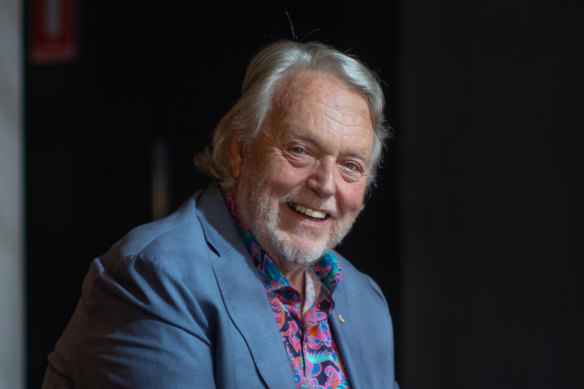
Mike Brady is one of Australia’s most prolific and successful jingle composers.Credit: Simon Schluter
Mike Brady takes a deep breath and launches into one of his most well-known songs.
“Lucky you’re with AAMI,” he sings, drawing out his vowels in an animated, high-pitched falsetto. “Yeah, that’s a catchy one.”
Brady’s name is typically synonymous with Up There Cazaly – the famous anthem of the AFL grand final.
But the 76-year-old musician’s quick wit and melodic flair are also behind some of Australia’s most successful jingles, including for SPC baked beans and spaghetti, Hard Yakka (that one’s more of a chant), and Dodo internet.
His jingle for AAMI Insurance – inspired by a boating accident – still plays on television and radio ads.
“When they [AAMI] asked for a jingle, I had a few notes but no words,” Brady says. “There was an incident on my boat one night and a skipper came by to check the damage. He said ‘Oh, you can’t help bad luck’, and I thought ‘Gosh, lucky I have insurance.’”
Brady spontaneously bursts into song multiple times during our phone interview. He whistles, riffs, hums and snaps his fingers, triggering a wave of nostalgia that sweeps us back to a time when the jingle was king of commercial advertising.
Born in England, Brady’s first memories of jingles revolve around his mother, who used to dance around their living room singing 1950s beer commercials.
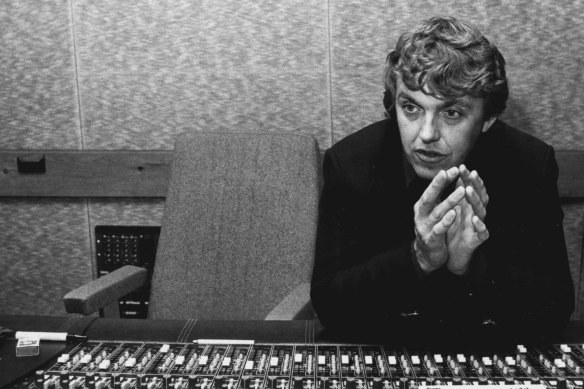
Mike Brady in a recording studio in West Melbourne in 1982.Credit: Fairfax Media
“A double diamond, works wonders, works wonders, so drink one today,” Brady bellows. “Mum never drank a drop of beer, but she adored that jingle.”
Brady jokingly estimates he’s written thousands of jingles for “anyone and everyone” from canned food to car companies.
But despite their undeniable effectiveness, jingles have become increasingly sparse in contemporary advertising, replaced instead by pop songs.
“In the golden days, nine out of 10 commercials had jingles; you would sometimes catch yourself humming a tune in the supermarket or lying awake at night with a ridiculous one stuck in your head,” Brady laughs. “Jingles are still used today, but they’re less common. There’s nothing quite like them any more.”
Why so catchy? The musical mechanics behind an immortal jingle
Award-winning Australian composer Peter Sullivan has toured with The Seekers, arranged music for John Farnham and the Melbourne Symphony Orchestra, and worked as a session player on major motion films, including the 1986 classic Crocodile Dundee.
But the 74-year-old is best known for a 30-second jingle for the Reading Writing Hotline (1300 655 506), a national telephone service for adults struggling with literacy.
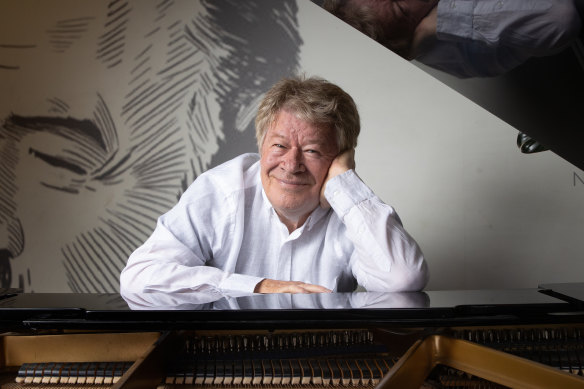
Peter Sullivan Credit: Simon Schluter
Legendary cartoonist Alexander Stitt (creator of Sid the Seagull in the Slip Slop Slap campaign) asked Sullivan to write a simple, jazzy piece.
“Alex said to me, ‘Here’s the number, make sure it’s catchy’,” Sullivan laughs. “We recorded the middle zero separately, which gives the sequence a little pop and makes it more memorable.”
Session singer Andrea Lee (Sullivan’s now partner) recorded the original vocals for the jingle. The duo occasionally sing the hotline number for unsuspecting friends at dinner parties.
Reading Writing Hotline manager Vanessa Iles says the 32-year-old jingle has been integral to the organisation’s long-lasting success.
“Many of our customers struggle with literacy, so a jingle to help remember our number is essential,” she explains. “In 2024, we still have people calling and singing the jingle back to us.”
So, what makes a jingle so catchy?
Melbourne University senior marketing lecturer Dr Danielle Chmielewski-Raimondo has never called Pizza Hut for home delivery but can recite the phone number off by heart.
She says music is a powerful tool for memory retention and subconscious brand recall.
“We often attach certain memories to pieces of music, and music elicits meanings and triggers emotions,” she explains.
“A catchy jingle uses rhyme and repetition, but a really memorable jingle often triggers feelings of nostalgia – it’s why countless people associate Happy Little Vegemites with their childhood. That connection – between brand and memory– promotes customer loyalty.”
Jingles dominated television and radio advertisement slots from the 1940s to the early 2000s, but Chmielewski-Raimondo struggles to think of a memorable jingle from the past decade.
“The advertising market has really changed. Jingles still exist … but in 2024, they’re less prevalent, less necessary and less relevant to modern audiences.”
Gen Z and the pop song: Meet the jingle’s replacement
In Abbotsford, Nigel Ross has just finished a recording session. He’s got a 15-minute break before jumping into an afternoon meeting with clients.
The composer and veteran radio presenter has spent the past 34 years recording and writing jingles at his studio, Image On Line, for some of Melbourne’s biggest brands and companies, including Silver Top Taxis (“131 008, So many taxis, why wait”).
Ross has noticed a decrease in the use of jingles but is hesitant to confirm a terminal diagnosis. “I don’t think jingles are dead, but the landscape has definitely shifted,” he says.
“We are still writing heaps of jingles for radio, but young people in advertising are moving away from traditional media like television and radio, so they don’t have room for jingles, or what we’d call ‘sonic triggers’ or ‘sonic branding’,” he explains.
Decades ago, Ross says some jingle writers would get paid thousands of dollars and work in “gigantic studios with real instruments and live vocalists”.
“Now anyone with a laptop and a speaker can write a jingle,” he says.
There has been a seismic shift in the advertising world in recent decades in favour of pop songs over original jingles. Icona Pop and Charli XCX’s I Love It is the anthem for Kentucky Fried Chicken, a satirical version of LMFAO’s Party Rock Anthem plays for streaming subscription company Hubbl, while Fleetwood Mac’s Go Your Own Way is automatically associated with car commercials.
Chmielewski-Raimondo says the fragmented nature of modern marketing makes it challenging to advertise mass brands to large audiences.
“If you’re going after the Millennial or Gen Z market, then jingles don’t really have a place in your strategy,” she says. “Young people are much more likely to engage with a product on YouTube or a viral TikTok. It’s partly why more brands are using pop songs or recycling old hits – they know it will resonate with their audience.”
Ross laments the decline of jingles, describing it as a “loss of creativity”.
“Younger people in advertising prefer to buy the rights to well-known songs instead of writing an original jingle,” he says. But when you use a song, people usually identify the song or artist before the brand. “If you use a jingle, people immediately recall the brand.”
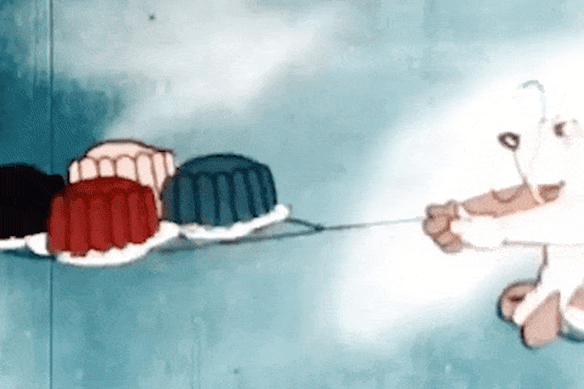
Bertie the Jet sings the iconic Aeroplane Jelly jingle in a 1940s cinema advertisement.Credit: National Film Sound Archive
Death of the jingle, birth of the meme
The National Film and Sound Archive of Australia (NFSA) has a Sounds of Australia registry – an annual time capsule of historically and culturally significant “audio moments”.
Each year, Australians nominate sound recordings – beloved songs, albums, advertising jingles, speeches, radio clips and podcasts – that amplify “who we are, where we’ve been, and where we’re headed”. Eligible recordings need to be more than 10 years old.
The archive features famous jingles including Happy Little Vegemites, Slip Slop Slap, Louie The Fly and Aeroplane Jelly.
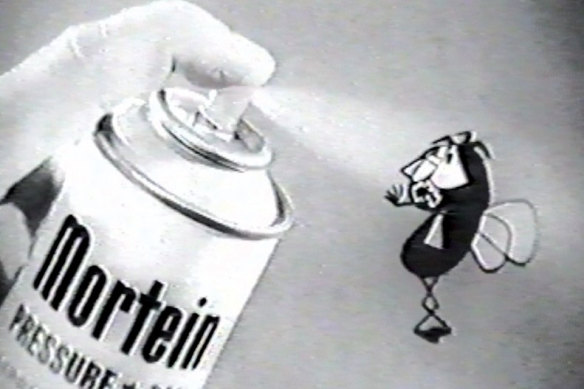
Louie The Fly from a 1960s Mortein ad. Credit: Mortein
Chief curator Meagan Loader says jingles have to resonate with audiences and represent “a specific moment in time for a community”.
“We look for sounds that have embedded themselves in the collective memory of the nation,” she says. “In the 1940s, Aeroplane Jelly was played up to 100 times a day on Sydney radio.”
Loader acknowledges the decline of modern jingles but says audiences are finding new ways to engage with advertising.
“The concept of a jingle is now replicated by memes,” she explains. “At its core, a jingle is a short piece of memorable music. That’s very similar to the memes and viral short audio clips we see across platforms like TikTok.”
Does that mean memes could be inducted into the Sounds of Australia archive?
“Absolutely,” Loader laughs. “I think we’ll start to see more viral content – especially content that has shaped the collective experiences of Gen Z audiences.”
‘People still care’: Brady, Perry and a footy jingle
Last week, Mike Brady stepped onto a stage at the Melbourne Cricket Ground, ahead of American pop star Katy Perry, to perform his most famous song: Up There Cazaly.
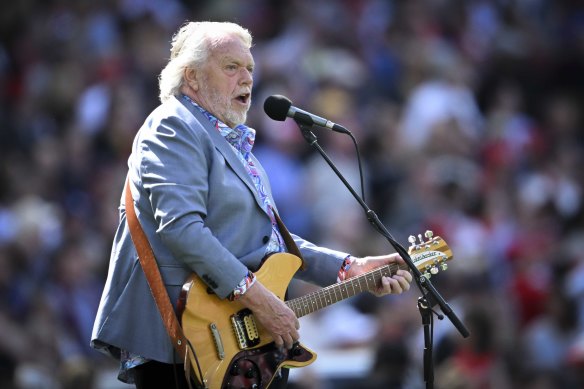
Mike Brady performs at the 2024 AFL grand final.Credit: Eddie Jim
Originally composed as a short jingle for Channel Seven’s coverage of the Victorian Football League in 1979, the ballad has become a staple of grand final pre-entertainment.
Brady strummed his guitar and belted the lyrics, reaching for the final note with gusto. A chorus of 100,000 spectators sang along with their hands in the air.
“I don’t want to say the jingle is dead – things have changed, but it’s still there and people still care,” he says a few days later.
“Who knows, maybe it will have a comeback.”
Our Breaking News Alert will notify you of significant breaking news when it happens. Get it here.